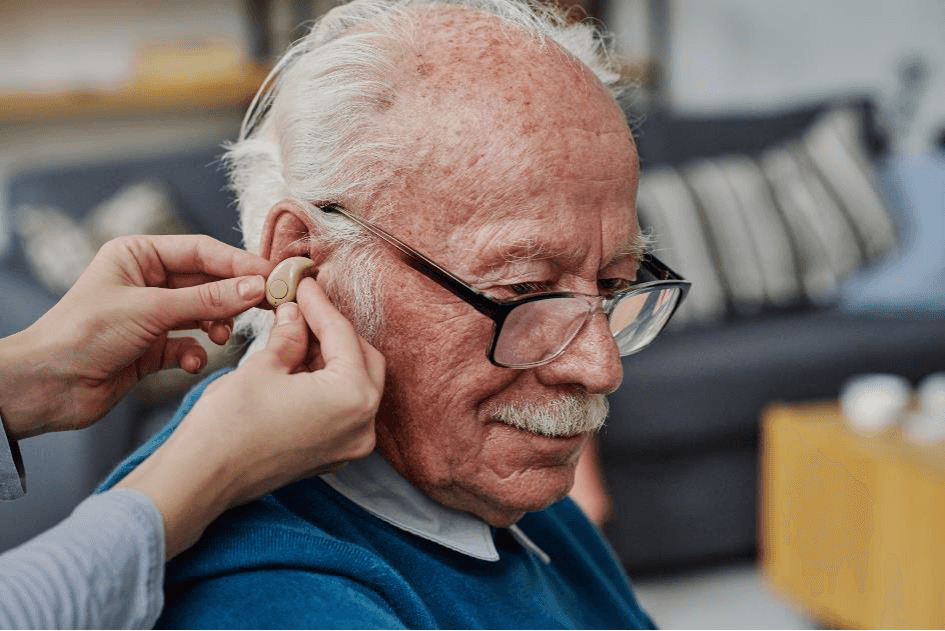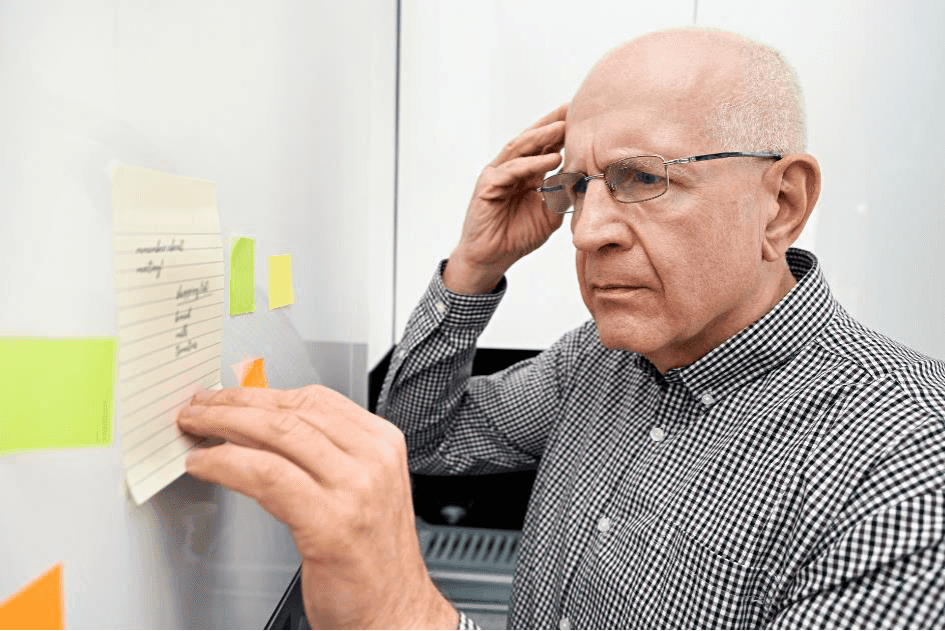How do aging processes change the body and what can be done about it?
External editorial

Hearing and vision: Consequences of signs of wear and tear in old age
Many areas of the body deteriorate with age. These include hearing and vision. Accordingly, the affected persons find it increasingly difficult to orient themselves in their environment and to communicate with other people. This can lead to problems in everyday life and, in extreme cases, possibly even to loneliness.
Hearing in old age
In the early years of life, hearing functions without any problems in a healthy person. This means that it is possible to talk to other people, pick up sounds from the environment and enjoy music. The problems with hearing typical of old age are also known as age-related hearing loss.
Decrease of hearing in old age, reasons and symptoms
There are several reasons for this phenomenon. The main cause is wear and tear in several areas of the ears. The affected parts of the hearing include:
- the hair cells of the inner ear,
- the auditory nerve
- and the auditory center.
Affected individuals do not become hard of hearing overnight - rather, age-related hearing loss is a gradual process that continues to progress. In most cases, both ears are affected equally.
The symptoms of the problem vary. For example, affected persons initially find it more difficult to understand their counterpart in conversations - they have to ask more often.
In addition, even pleasant background noises such as nice music seem more like unpleasant noise. Finally, there are sounds that are no longer perceived at all. This includes, for example, the ringing of the telephone or the natural soundscape of a forest. In some cases, tinnitus is added.
The reasons for this include simple wear and tear of the hearing and noise exposure over the past decades. Heredity also plays a role. In addition, other diseases can contribute to weakened hearing. Diabetes and cardiovascular disease are particularly relevant here.
Prevention and treatment of the problem
Various steps can be taken to prevent age-related hearing loss. First of all, it is advisable to give up smoking. Among many other problems caused by excessive nicotine consumption, it has a negative effect on hearing.
In addition, noise should be avoided. Among other things, this means not listening to music too loudly and wearing hearing protection when working in a noisy environment.
Protecting the ears from the cold in winter can also help. In addition, care should be taken to detect cardiovascular disease and diabetes in time and have them treated.
Hearing loss itself cannot be treated. However, it is possible to reduce the symptoms. In most cases, digital hearing aids are used for this purpose.

Alternatively, the insertion of a hearing implant is possible if the hearing loss is particularly severe. Furthermore, affected persons can learn to lip-read in order to be able to understand the person they are talking to more easily.
Vision in old age
Vision also deteriorates with advancing age. This is quite normal and therefore no reason for great concern. However, those affected should take action to avoid any disadvantages in everyday life.
The phenomenon of presbyopia
Most people are affected by declining vision from the age of 40. In the following decades of life, the process continues to progress. The phenomenon is referred to as presbyopia or presbyopia. Those affected find it more difficult to recognize objects in the immediate vicinity of the eye.
Reading in particular can become a problem. The reason for this is that the lens of the eye is no longer able to change shape. It therefore becomes increasingly rigid. In addition, the eye muscles are no longer as efficient as they were in younger years of life.
Solutions to the problem
The classic solution in this case is the use of so-called varifocals. The lenses of such glasses enable vision in the distance as well as in the immediate vicinity by means of a transition. Alternatively, appropriate contact lenses can be used, but this way is not very common.
Since presbyopia is a natural process, there is no way to prevent it. However, it certainly makes sense to have one's vision checked regularly by a specialist in order to rule out any further previously undetected problems around the eyes.
Mobility decreases with age
Another area of life in which certain changes occur with age is mobility and the ability to move. For example, in some cases, aging individuals find it increasingly difficult to go about their daily lives without assistance.

Mobility problems in old age and their causes
Here, the restriction of movement can occur to varying degrees and for varying lengths of time. For example, if an older person falls, their mobility is often significantly limited as a result of an injury - but often only for a certain period of time. Alternatively, restrictions to the musculoskeletal system can occur permanently. In this case, certain movements can either no longer be performed at all or only with a great deal of effort.
This can affect the entire mobility or only certain actions. Accordingly, everyday life becomes more cumbersome and slower. The reasons for this vary. Often they are related to the usual signs of wear and tear in old age. Among other things, the muscles increasingly deteriorate.
Incidentally, this process already begins around the age of 30, unless counteracted accordingly. Furthermore, the stability of the bones decreases with advancing age. In addition, diseases can be the trigger for a corresponding problem. These include:
- Osteoarthritis,
- multiple sclerosis,
- gout
- as well as psychological problems.
Everyday life management and prevention
Often immobility progresses. In this case, it is important to use various aids to ensure that everyday life can continue to be managed. Among other things, this is possible with walking aids or a rollator.
In the case of severely limited mobility, the use of a wheelchair should be considered. In addition, the home environment can be adapted. This is possible, among other things, by redesigning the individual rooms (bathroom, kitchen, etc.) so that it is also possible for a person in a wheelchair to carry out the necessary tasks of everyday life.
If climbing stairs becomes impossible, a stair lift provides appropriate assistance. When making the decision, the person concerned should pay attention to some key details. Among other things, this includes obtaining appropriate information in good time. In addition, there are subsidies from the nursing care insurance fund that significantly reduce the costs. These must also be applied for early on.
But what can be done to prevent limitations of the musculoskeletal system? The most important thing here is to exercise and do sports regularly.
This applies to both younger and older people. Both endurance sports such as jogging or cycling and regular strength training are helpful. This keeps the musculoskeletal system in exercise, and also counteracts muscle deterioration to a certain extent.

Of course, when doing sports should choose an intensity that is appropriate for the state of health of each person. Otherwise, there is a risk of injury and overload. In older age, even simple activities such as gardening can help keep the musculoskeletal system in exercise.
Memory and cognitive abilities decline
Another important part of the body that we need throughout our lives is the brain. It is responsible for memory as well as information processing, i.e. the ability to perform cognitive tasks.
Decline of the brain in old age
Like many other areas of the body, the brain degrades as we age. In advanced decades of life, various remodeling processes begin in the brain.
These are often perceived as degradation, as they cause individuals to become more forgetful. This can affect simple information such as names or appointments, among other things. Especially the short-term memory decreases with age, which leads to the fact that the brain needs longer to store certain facts.
These processes are completely normal and therefore initially unproblematic. However, if the memory disorders occur to a particular extent and affect everyday life more seriously than in people of the same age in the environment, a doctor should be consulted. In this way, it is possible to clarify whether the reason for the memory problems is not a disease such as dementia.
Possibilities for prevention and staying active
However, there are various ways to counteract the decline in brain performance. As with a look at mobility, the most important thing is to stay active.
Among other things, constant learning plays a role in this. This involves stimulating the brain with new impressions. Interactions or actively getting to know a culture or a different environment are relevant here. This shows that brain training does not necessarily always have to be perceived as such, but that hobbies also play a decisive role.
In addition to traveling, making music and dancing, among other things, promote brain performance. The occupation with foreign languages likewise a positive effect, particularly if a language is learned. So those who regularly interact socially and engage in certain leisure activities are doing a lot to stay cognitively fit.
Additionally, regular exercise can help a person stay mentally fit. This form of activity has particularly positive effects on memory performance.
Stomach and intestines: changes from saliva production to intestinal flora
Another part of the human body that changes with age is the gastrointestinal tract, or digestive system. Here, there is a growing sensitivity to different foods as we age.
What are the changes in the digestive system?
The potential problems in old age already start in the oral cavity. For example, reduced saliva production can be observed in many people of advanced age. These and other factors have the consequence that swallowing becomes more difficult.
In addition, the possibilities for food intake are more limited. Thus, the stomach can absorb less food, and at the same time it works much more slowly than in younger people. As a consequence, people of senior age are fuller more quickly, which means that less food can be absorbed and processed.
A similar effect can be observed in the intestinal tract. As people get older, fewer bacteria necessary for digestion form in this area of the body. Accordingly, the processes change. The many-sided changes can lead to the occurrence of various other problems. These include, among others:
- a reflux
- as well as inflammations in the gastrointestinal tract.

How should affected persons deal with the changes?
If swallowing problems or pain occur, it is always advisable to consult a doctor. Based on a diagnosis, the doctor can help to get the problem under control at an early stage or at least alleviate the symptoms. Accordingly, the quality of life is maintained. It is also possible to prevent a health problem that has not been treated from spreading and becoming more severe.
In addition, attention can be paid to a healthy and suitable diet. It is important to avoid too much fat and sugar. Moreover, dietary fibers play a crucial role. They help maintain the health of the intestinal flora. Foods rich in fiber include:
- Spelt,
- Corn,
- rye
- as well as various whole grain products.
No less important is a sufficient supply of water. This ensures that digestion can proceed more easily. Another aspect shows how much the individual factors of a healthy life in old age are interrelated.
For example, a sufficient protein intake is important to counteract the increasing breakdown of muscles. In order for the body to be able to absorb this substance, intestinal health plays a particularly important role.
With a conscious nutrition a certain prevention takes place thus on several levels. By the way, this way of life also has an influence on the health of the brain to a certain extent.
Various typical diseases in old age and ways to prevent them
In addition to these changes in the body, there are some diseases that occur more frequently at an older age. These include:
- Stroke,
- Parkinson's disease
- and dementia.
Stroke
A stroke results in a part of the brain not being supplied with sufficient blood. The reason for this is the blockage of a vessel by a blood clot.
Risk factor age and the consequences
Stroke is one of the typical diseases that occur predominantly in old age. According to the website pflege.de, 80 percent of people who are struck by such a stroke of fate have already passed the age of 60. On average, men are younger at the time of the stroke (68 years) than women (75 years).
In addition to age, other relevant factors for the occurrence of a stroke include stress and excessive alcohol consumption. Smoking and obesity also play a role. The consequences of a stroke are mainly paralysis, speech problems and orientation problems.
Possibilities for prevention
However, there are some ways to prevent a stroke. These include having your blood pressure checked regularly. In addition, care should be taken to ensure that cholesterol levels are within normal limits. Furthermore, it makes sense to give up smoking completely. Finally, overweight can also play a role. Consequently, a healthy diet and regular exercise (several times a week) should be taken into account to reduce the risk.
Parkinson's disease
Parkinson's is another disease that occurs mainly in old age. Thus, for most of those affected, it does not begin until after the age of 50. The disease is particularly common after the age of 70.
Typical symptoms include stiffness of the muscles and slowing of movements. The best-known sign, however, is certainly tremor. It is mainly present in moments when the affected person does not move.
Parkinson's is not curable. However, with the help of medication, a certain quality of life can be maintained over a longer period of time. In addition, the disease progresses rather slowly. Furthermore, the disease can be delayed and mitigated by a healthy diet.
Dementia
Dementia is also a disease that is typical for the later years of life. According to the website pflege.de, the risk of this disease increases steadily from the age of 65. The group of people older than 90 is particularly affected.
While short-term memory is affected at the beginning of the disease, as it progresses, information imprinted in long-term memory is lost bit by bit. As a result, people lose certain skills that they need for everyday life and become increasingly dependent on help. Reasons for dementia include:
- Alcohol abuse,
- smoking,
- lack of exercise,
- obesity
- or depression.
Accordingly, prevention can be achieved to a certain extent by integrating a healthy lifestyle into everyday life - from abstaining from addictive substances to sufficient exercise and various measures to maintain and promote mental health.

Conclusion
With age, the functional ability of various areas of the body decreases. In addition to the eyes and ears, these include the ability to move, memory and the function of the gastrointestinal tract. The risk of certain diseases also increases. For each of these developments, there are, to a certain extent, ways to mitigate the symptoms as well as to prevent them. Basically, a healthy diet and activity at various levels play a role. Finally, affected persons should clarify symptoms with a doctor in order to be able to diagnose and treat potential diseases in time.
Sources
- Altersschwerhörigkeit (Presbyakusis) (pflege.de)
- Altersschwerhörigkeit (Presbyakusis) (HNO-Ärzte im Netz)
- So stärken Sie die Sehkraft im Alter (mdr.de)
- Eingeschränkte Mobilität: Wenn der Körper nicht mehr richtig kann (Alippi.de)
- Veränderungen der Gedächtnisleistung im Alter (Sozialverband Deutschland)
- Wenn das Gedächtnis nachlässt: Darum werden wir im Alter vergesslich (Liebenswert Magazin)
- Gedächtnistraining: Wie Senioren geistig fit bleiben (ndr.de)
- Wenn der Verdauungstrakt altert (apotheken.de)
- Gesund essen im Alter: Neun Regeln (Apotheken Umschau)
- Risikofaktoren erkennen – dem Schlaganfall vorbeugen (Stiftung Deutsche Schlaganfall Hilfe)
- Parkinson: Welche Rolle spielt die Ernährung? (ndr.de)
- Diagnose Demenz: Krankheitsbild und Verlauf (Bundesministerium für Gesundheit)
Kurt Weber
Last updated on 09.03.2023
Your personal medication assistant
Browse our extensive database of medications from A-Z, including effects, side effects, and dosage.
All active ingredients with their effects, applications, and side effects, as well as the medications they are contained in.
Symptoms, causes, and treatments for common diseases and injuries.
The presented content does not replace the original package insert of the medication, especially regarding the dosage and effects of individual products. We cannot assume liability for the accuracy of the data, as the data has been partially converted automatically. Always consult a doctor for diagnoses and other health-related questions.
© medikamio